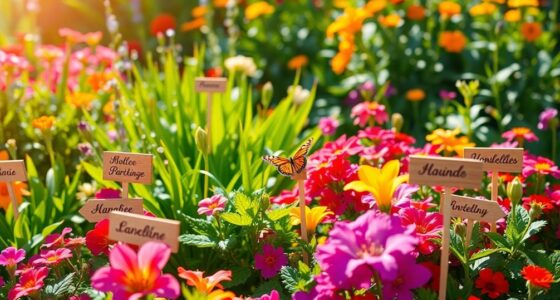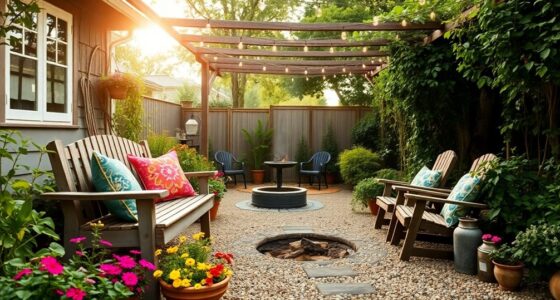To make your garden the envy of the neighborhood, start by embracing bold plant combinations. Layer tall plants at the back, medium in the middle, and low groundcovers in front. Create inviting relaxation zones with harmonious design and natural materials. Incorporate native plants to enhance biodiversity and attract local wildlife. Use sustainable gardening practices like composting and natural pest control to show your commitment to the environment. Don't forget to add unique touches like water features or cozy seating areas. Keep these tips in mind, and you'll discover even more ways to elevate your garden to the next level.
Key Takeaways
- Utilize maximalist planting techniques to create a vibrant and layered garden with bold focal points and seasonal interest for year-round appeal.
- Design inviting relaxation zones with natural materials and soothing water features to enhance the overall atmosphere and encourage enjoyment.
- Foster community engagement through workshops and events, promoting collaboration and shared gardening knowledge among neighbors.
- Enhance biodiversity by incorporating native plants, creating habitats for wildlife, and allowing areas to flourish naturally for ecological balance.
- Implement sustainable gardening practices like composting and organic pest management to cultivate a thriving, eco-friendly garden that stands out.
Embrace Maximalist Planting Techniques
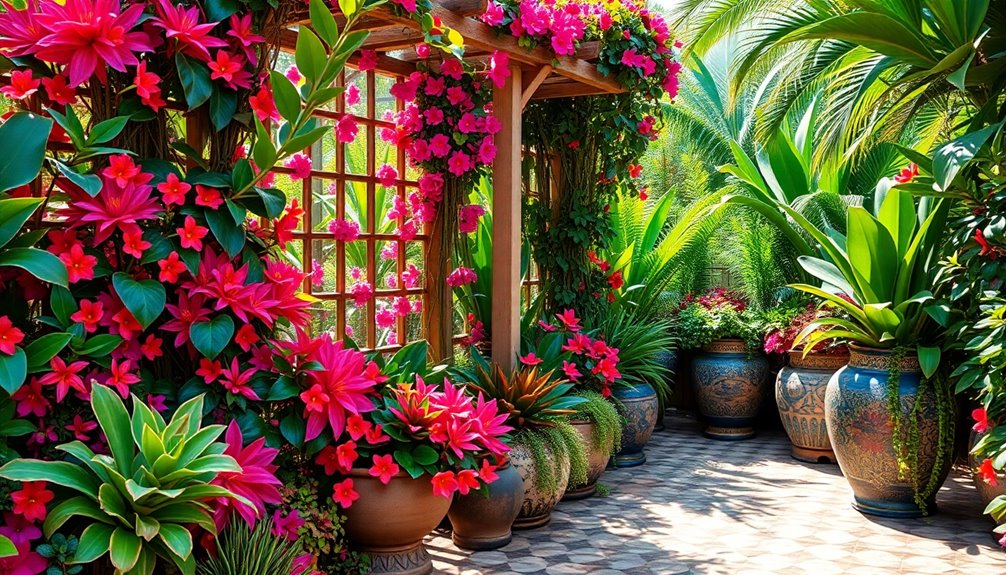
While you may think a minimalist garden is the way to go, embracing maximalist planting techniques can transform your outdoor space into a vibrant, lush oasis.
Start by creating a basic layout to visualize plant placement, layering tall plants in the back, medium ones in the middle, and low groundcovers in front. Choose big, bold plants like sunflowers and hollyhocks for eye-catching focal points, and add flowering vines for whimsy. Incorporating contrasting colors can enhance visual interest and make your garden stand out even more. Additionally, consider using seasonal interest plants to ensure your garden remains visually appealing throughout the year.
Use underplanting to fill gaps beneath shrubs and trees, maintaining balance with accent colors. Incorporate texture by adding gravel paths or stone walls, and ensure seasonal interest with diverse plant choices.
Create Inviting Relaxation Zones
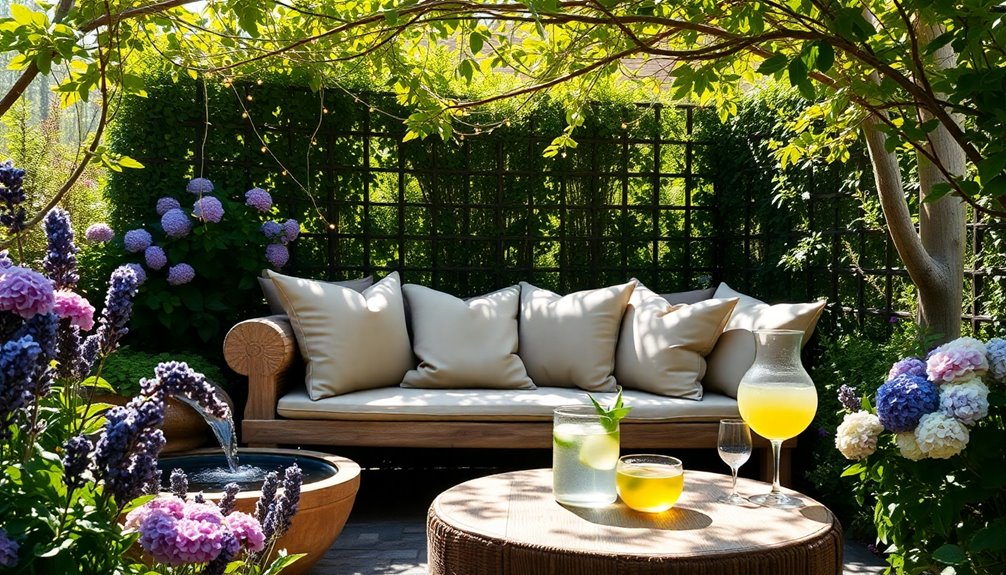
How can you turn your garden into a serene retreat? Start by creating inviting relaxation zones that promote calmness.
Keep your layout simple and uncluttered, using shades of green and cream to maintain a soothing atmosphere. Incorporate matching wood furniture and structural elements like hedges and topiary for year-round appeal to enhance the garden's beauty throughout all seasons. Using natural materials like reclaimed wood can further enhance the rustic charm of your garden.
Establish a sense of enclosure with fences, trellis, or pleached trees to enhance privacy and tranquility. Add water features like ponds or fountains for soothing sounds and reflections.
For seating, provide comfortable areas in both sun and shade, ensuring they're visible from the house to encourage use. By balancing these elements, you'll cultivate a garden that's not just beautiful, but a true retreat.
Foster Community Engagement
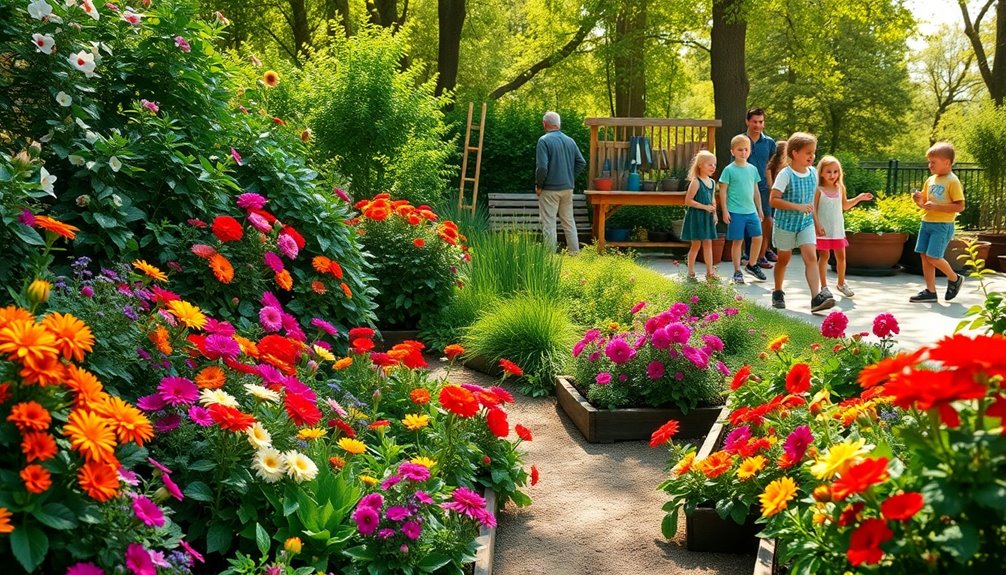
What better way to enhance your garden than by fostering community engagement? Start by establishing reliable communication through a message board, social media groups, and regular updates. This keeps everyone informed about garden chores and events. Additionally, sharing information on healthy gardening practices can help everyone achieve better results.
Create a learning environment by hosting workshops with local experts, encouraging skill sharing, and developing programs for all ages. Promote social interaction by organizing community events like planting parties and movie nights, allowing gardeners to connect.
Extend engagement year-round with fall festivals, off-season workshops, and spring flings to welcome new members. By building a strong community around your garden, you not only enhance its appeal but also create a vibrant space for everyone to enjoy. Additionally, community gardening promotes collaboration and shared knowledge among participants, enriching the gardening experience for all involved.
Incorporate Naturalistic Design

Incorporating naturalistic design into your garden not only enhances its beauty but also creates a sustainable ecosystem that thrives with minimal intervention.
Start by choosing native and robust plants that flourish in your region, providing seasonal interest and resilience. Layer your plantings to mimic natural habitats, mixing trees, shrubs, and groundcovers for a dynamic look. Natural habitats consist of multiple planting layers, which can greatly enhance the diversity and visual appeal of your garden. This layered approach can also increase biodiversity, fostering a healthier environment for both plants and wildlife.
Aim for a natural feel by using drifts of plants in random patterns and avoiding massive clumps. Maintain a strong structure with evergreens or walls, allowing delicate plantings to shine.
Lastly, encourage self-seeding and natural growth to reduce maintenance. This approach not only beautifies your space but also supports local wildlife, making your garden the envy of the neighborhood.
Enhance Biodiversity in Your Garden

While enhancing biodiversity in your garden might seem like a daunting task, it can be achieved with simple, intentional choices.
Start by planting diverse species, especially native plants that attract local wildlife and pollinators. Incorporate seasonal blooms to ensure a steady supply of nectar. You might also consider the recent climate changes that affect plant selection and maintenance. Additionally, choosing native species helps to support local ecosystems and wildlife.
Create habitats by adding bug hotels, birdhouses, and water features, which will encourage various creatures to visit. You can also leave areas untended and allow dandelions to flourish; they're great for pollinators.
Finally, consider adding compost piles and rotting logs to enrich your soil and provide shelter.
These small changes will transform your garden into a thriving ecosystem, making it the envy of your neighborhood.
Implement Sustainable Gardening Practices
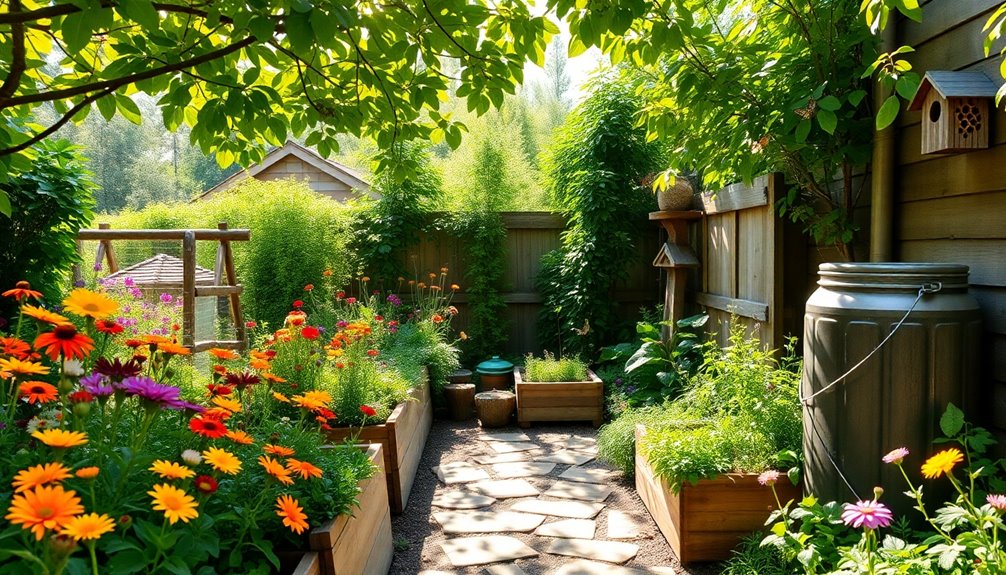
Creating a thriving ecosystem in your garden not only enhances biodiversity but also sets the stage for sustainable gardening practices.
Start by composting kitchen scraps and garden waste, enriching your soil while reducing landfill waste. Opt for native plants to minimize water use, and consider rainwater harvesting to irrigate efficiently. Studies show that gardens can sequester carbon, contributing to climate change mitigation, and incorporating sustainable forestry practices can further support this goal.
Promote healthy soil with organic fertilizers, regular soil testing, and cover cropping. Use eco-friendly materials, like reclaimed wood for pathways and sustainable planters.
Manage pests naturally by introducing beneficial insects and using organic pest control methods.
Lastly, conserve water with drought-tolerant plants and efficient irrigation techniques.
Frequently Asked Questions
What Are the Best Plants for Attracting Pollinators to My Garden?
To attract pollinators to your garden, choose native plants like milkweed, coneflowers, and goldenrod.
These species provide essential nectar and pollen while thriving in your local climate. Incorporate annuals like cosmos and sunflowers for vibrant color and a steady food source.
Perennials such as bee balm and lavender also draw in bees and butterflies.
Don't forget herbs like basil and dill—they're not just useful for cooking, but they also attract beneficial pollinators!
How Can I Maintain My Garden During Extreme Weather Conditions?
Oh, you thought your garden could brave any weather? Think again!
To maintain it during extremes, choose resilient plants that laugh in the face of drought or frost. Prepare your soil like a chef prepping a gourmet meal—healthy and nutrient-rich.
Water deeply but sparingly, so your plants dig deep for moisture.
Finally, throw some shade cloth over them like a stylish hat, and watch your garden thrive even when Mother Nature misbehaves!
What Tools Are Essential for Beginner Gardeners?
As a beginner gardener, you'll need a few essential tools to get started.
Grab a pair of gardening gloves to protect your hands, and a hand trowel for planting and digging small holes. Pruning shears will help you shape your plants, while a garden fork and spade are perfect for soil preparation.
Don't forget a watering can or hose to keep your plants hydrated. With these tools, you're well on your way to a thriving garden!
How Do I Choose the Right Soil for My Plants?
To choose the right soil for your plants, start by understanding the different soil types.
Determine what your plants need: vegetables like nutrient-rich, well-drained soil, while fruits may prefer acidic, peaty soil.
Conduct a soil test to check nutrient levels and amend your soil accordingly with compost or organic matter.
Don't forget about drainage; mixing in sand or perlite can enhance aeration and prevent waterlogged roots.
Happy gardening!
What Are the Benefits of Companion Planting in a Garden?
Companion planting offers numerous benefits for your garden.
You'll enjoy natural pest control, as certain plants repel harmful insects and attract beneficial ones.
It also improves nutrient uptake by enhancing soil fertility and structure.
You'll notice better pollination, too, thanks to attractive flowers drawing in pollinators.
Plus, by using space efficiently, you can maximize your garden's productivity.
Embracing companion planting creates a healthier, more vibrant ecosystem in your backyard.
Conclusion
By embracing these gardening techniques, your outdoor space can bloom like a vibrant tapestry, captivating everyone who passes by. Remember, a garden isn't just about plants; it's a place for relaxation, community, and sustainability. So, roll up your sleeves and let your creativity flourish. With a little effort, your garden will not only reflect your unique style but also inspire your neighbors to join in the green revolution, making your entire neighborhood more beautiful.


